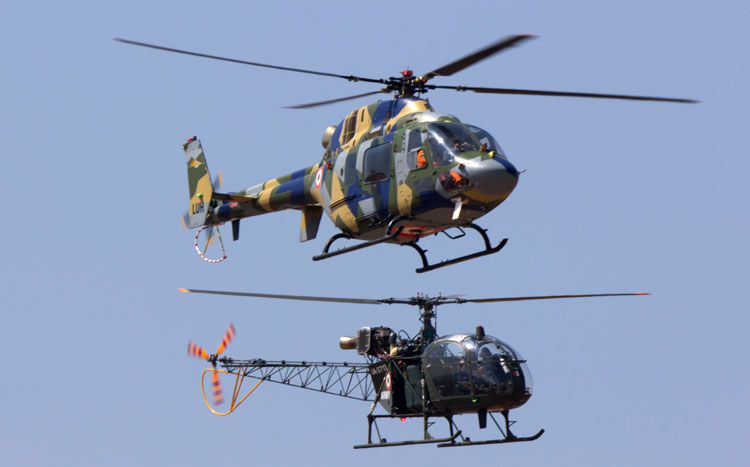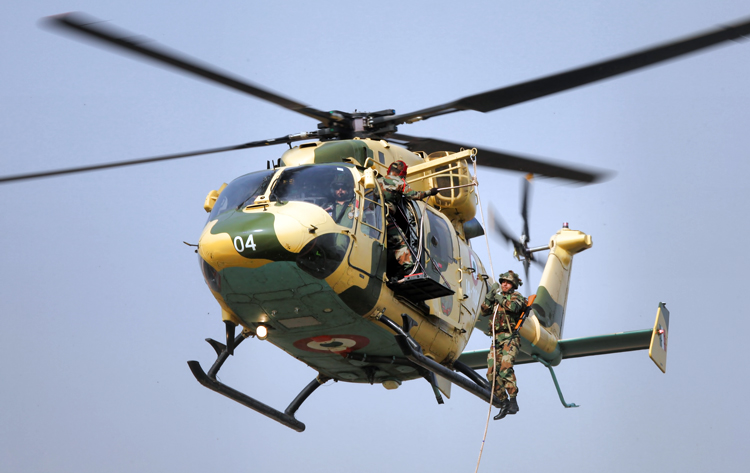INDIAN ARMED FORCES CHIEFS ON OUR RELENTLESS AND FOCUSED PUBLISHING EFFORTS

The insightful articles, inspiring narrations and analytical perspectives presented by the Editorial Team, establish an alluring connect with the reader. My compliments and best wishes to SP Guide Publications.

"Over the past 60 years, the growth of SP Guide Publications has mirrored the rising stature of Indian Navy. Its well-researched and informative magazines on Defence and Aerospace sector have served to shape an educated opinion of our military personnel, policy makers and the public alike. I wish SP's Publication team continued success, fair winds and following seas in all future endeavour!"

Since, its inception in 1964, SP Guide Publications has consistently demonstrated commitment to high-quality journalism in the aerospace and defence sectors, earning a well-deserved reputation as Asia's largest media house in this domain. I wish SP Guide Publications continued success in its pursuit of excellence.
- Operation Sindoor: Resolute yet Restrained
- India’s Operation Sindoor Sends a Clear Message to Terror and the World – ‘ZERO TOLERANCE’
- Japan and India set forth a defence cooperation consultancy framework, talks on tank and jet engines
- Terrorist Attack in Pahalgam in Kashmir: Unfolding a long surgical war against PAK
- Lt General Pratik Sharma takes over Command of Indian Army's Northern Command
Comforting from the Cold
The government could consider providing onboard heating and ventilation system in Cheetah and Chetak helicopters as well – same as being done for the Light Utility Helicopters (LUH)
 |
The Author is Former Director General of Information Systems and A Special Forces Veteran, Indian Army |

The Defence Acquisition Council (DAC) headed by Defence Minister Rajnath Singh had approved the acquisition of 12 x Light Utility Helicopters (LUH) from Hindustan Aeronautics Limited (HAL) in November 2021. The first delivery of these LUH is scheduled to begin in August this year.
Reports of January 29, 2022, intimated that the LUH being built by HAL will include an onboard heating and ventilation system from Liebherr Aerospace & Transportation, after the French company signed a contract worth an undisclosed value with HAL. Liebherr Aerospace & Transportation and HAL have previously co-operated on military aviation programmes like the Dhruv Advanced Light Helicopter (ALH), Tejas fighter aircraft and Dornier Do 228 maritime patrol aircraft.
As of January 2022, HAL has produced 335 x Dhruv helicopters for domestic, including for the Indian Army, Indian Navy and the Indian Air Force (IAF), and export markets logging more than 3,40,000 flying hours. The ALH Mk-III with new Shakti-1H engines has excellent high altitude performance; it can operating at altitudes over six km and has seating capacity for 14 x fully combat equipped troops. The armed version of the ALH is ‘Rudra”; equipped with forward looking infrared (FLIR) and Thermal Imaging Sights Interface, one 20mm turret gun, 70mm rocket pods, anti-tank guided missiles (ATGM) and air-to-air missiles.
The Light Utility Helicopters (LUH) being built by HAL will include an onboard heating and ventilation system
The Indian military urgently needs to replace the 187 x Cheetah and Chetak helicopters held in its inventory which are already obsolete. According to the ‘IAF, IA and IN Aircraft Losses Database’ (covering the period from November 23, 1963 to April 10, 2019), 43 helicopters were lost in this category of helicopters up to April 2019.
Since the LUH is meant to replace the Cheetah and Chetak helicopters, the 12 x LUH being procured this year will only meet a miniscule requirement. Logically, the HAL needs to expand the LUH production lines, perhaps in conjunction with the private industry, to meet the operational requirements of the Indian Military. This is all the more important because more focus will likely continue towards exports given the target of $5 billion defence exports by 2025.

At the same time, it is good to know that the French firm Liebherr will be providing onboard heating and ventilation system in the LUH being produced by the HAL. But it is also obvious that replacing the full complement of the obsolete 187 x Cheetah and Chetak helicopters with the LUH may likely take another few years. Therefore, the government could consider providing onboard heating and ventilation system in Cheetah and Chetak helicopters as well – same as being done for the LUH by the same French firm or a modified version of the same due to different designs of these helicopters compared with that of the LUH.
Temperatures in very high altitude areas like the Saltoro Range in the Siachen Glacier are in the extreme. The temperatures in winters are extremely low while due to the hot air in summers the helicopter may carry just about one-two jerry cans of kerosene or equivalent load to forward posts on the Saltoro Range. Onboard heating and ventilation system in helicopters in such areas have been more of necessity in high and very high altitude to comfort the pilots, not a luxury.
A recent example of the bungled project of all-weather border outposts for the Indo-Tibetan Border Police (ITBP) in Ladakh; an infrastructure project reduced to a non-starter after five years of work and investment of crores of rupees
In terms of comforting users from the cold in very difficult and hazardous terrain, unfortunately policy makers and bureaucrats sitting in airconditioned offices either don’t bother at all or lose interest after sanctioning the project resulting in crores of rupees and time loss with the users left high and dry. A recent example of this is the bungled project of all-weather border outposts for the Indo-Tibetan Border Police (ITBP) in Ladakh as reported in the media on September 19, 2021; an infrastructure project reduced to a non-starter after five years of work and investment of crores of rupees, even as the India-China face off is continuing since May-June 2020.
The project involved construction of over 40 integrated Border Outposts (BOPs) announced by the government in 2015. These BOPs were supposed to be the first of their kind in the region with freeze-proof toilets, running water and temperature maintained above 22 degree Celsius at all times. The first BOP, as a pilot for the project, was sanctioned to be built for the ITBP in at Lukung, known as Gateway to Pangong Tso. The project was awarded to National Projects Construction Corporation (NPCC), a PSU under the Ministry of Jal Shakti. Five years later, and after spending over 20 crore (just for the pilot project), the project has, for all practical purposes, been declared a failure by the ITBP. The Ministry of Home Affairs (MHA) and the Ministry of Jal Shakti are blaming each other while media quoting MHA sources say MHA has not only stopped part payment to the NPCC for the project, but is also thinking of dumping the project altogether.
The Ministry of Home Affairs (MHA) and the Ministry of Jal Shakti are blaming each other while MHA has not only stopped part payment to the NPCC for the project, but is also thinking of dumping the project altogether
The NPCC blames the ITBP for withholding payments that resulted in the sub-contractor not maintaining the heating system and thereby negatively impacting the efficiency of the BOP. So, where are the supposed part payment held up, what was in the contract, and who is to blame? Meanwhile the NPCC has sent an additional bill of 1.35 crore to the ITBP.
Subsequent media reports of December 27, 2021, revealed that the Central Vigilance Commission (CVC) has taken cognizance of the tussle and has opened a probe into the ambitious border infrastructure project after complaints by ITBP that the National Projects Construction Corporation Ltd (NPCC) had failed to deliver the project to its satisfaction despite an expenditure of over 20 crore. According the media report, the NPCC has advised the MHA to hire another agency to complete the project if it is not satisfied with the work.
Finally, one can only feel sorry for what is happening. Will we ever get our priorities right? Hopefully, we will not witness a repeat of this type of corruption by default or design in the Vibrant Village Project (VVP) announced by Finance Minister Nirmala Sitharaman while presenting the budget on February 1, 2022. It is time to rely more on startups and the private industry rather than PSUs.





